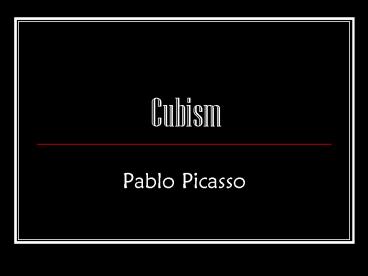Cubism PowerPoint PPT Presentation
1 / 19
Title: Cubism
1
Cubism
- Pablo Picasso
2
Cubism
- The Cubism movement started in the early 1900s.
- Pablo Picasso is one of the artists who pioneered
this movement. - So, where did this movement come from?
3
The mind of Pablo Picasso
http//en.wikipedia.org/wiki/Pablo_Picasso
4
Pablo Picasso
- Pablo Picasso was born in 1881 in a small town in
southern Spain - His father was a painter who taught art
- Picasso was amazing at an early age he attended
the Royal Academy of Madrid starting at 16 - Picassos teachers made him draw from plaster
casts, which he thought was a ridiculous way to
learn, so he began to work on his own - His father disliked his rebellious behavior, long
hair and strange clothes he believed that
Picasso was wasting his talent, asking him, Why
dont you cut your hair and paint sensibly?
5
Picasso continued
- In 1900, Picasso went to Paris the center of
the art world. - In Paris, he lived in an old building and
constantly reflected on his dismal surroundings,
which is often depicted in his early, realistic
work. - Pablo Picasso was creating his artwork during the
early to mid 1900s - Picasso didnt sell a lot of his work in his
early years, but he is now one of the worlds
most famous artists - His career lasted more than 70 years
- Picasso lived to be 92 years old
6
Picassos influence on Cubism
- No artist has affected modern art more!
- Picasso has completed thousands of masterpieces
he went through a lot of different movements.
Even though a lot of people think all of his work
is weird, its not true!
7
Early pieces by Pablo Picasso
Autoportrait à la palette (Self-Portrait with a
Palette), oil on canvas, Autumn 1906.
1896 self-portrait.
http//en.wikipedia.org/wiki/Pablo_Picasso
8
Moving into Cubism
- Gertrude Stein, 1906
- http//en.wikipedia.org/wiki/Pablo_Picasso
Self-Portrait, 1907 http//www.artchive.com/artch
ive/P/picasso/self7.jpg.html
9
Aficionado, 1912
The Glass, 1911 http//www.artchive.com/art
chive/P/picasso/wineglss.jpg.html
http//www.artchive.com/artchive/p/picasso/aficion
a.jpg
10
L'Accordéoniste, a 1911
11
Picassos epiphany
- After Picasso had experienced the work of African
artists specifically masks and sculptures his
work became more simplified and angular. This
was the start of the Cubism movement. - Picasso had a vision regarding what he wanted to
represent through art with his new ideas. His
goals included the following
12
The goals of Cubism include
- Getting as close to reality as possible by
representing a real, natural object on a flat
canvas by showing every side of the object. - Taking each point of view and emphasizing the
geometric shapes by spreading all of these points
out on a canvas. - Unfolding an image.
- EXAMPLE Three Musicians, 1921
- As Cubism developed, Picasso began to combine
several points of view of an object and to
overlap them this led to some images becoming
almost unrecognizable.
13
Some things we need to know
- Line
- Positive Space
- Negative Space
- Value
14
Line
- Contour Line A line that defines the boundaries
of a form.www.artsmia.org/art_in_america/glossary
.html - Practice
- Remember use the RIGHT SIDE of your brain! Get
out of your LEFT SIDE and just experience the
process.
15
Positive Space Negative Space
- What is the Positive Space in this image?
- What is the Negative Space in this image?
16
Value
- The degree of light to dark
Different degrees of values can add interest to
an image by creating the idea of depth, texture
and more.
17
Pull it all together
- Cubism
- Line
- Positive Space
- Negative Space
- Value
- Using the influence of CUBISM, well be creating
Shattered Images
18
Shattered Images
19
Shattered Images

